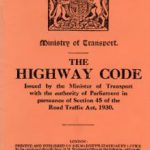If the Highway Code were a driver, it would probably be causing some mild concern to its children now. Born in 1931, the UK’s official, very British book of driving information, advice, guides and mandatory rules turned 85 this year.
A brief history
Pored over by learner drivers, the Code is one of the consistently best-selling books in the UK; when it was introduced, there were a paltry 2.3 million motor vehicles on UK roads, yet, an astonishing 7,000 people were killed in accidents every year. Today there are more than ten times as many vehicles, but less than half the number of road deaths.
Advances in safety knowledge, technology, medicine, as well as road and car design are no doubt responsible for much of this – but we shouldn’t underestimate the importance of the Code in helping to cull the carnage. From the beginning, the Code urged all road users to be careful and considerate towards others, putting safety first.
Safety First
Putting the safety of other road users first has remained a constant. The current edition of the Code begins:
‘The most vulnerable road users are pedestrians, particularly children, older or disabled people, cyclists, motorcyclists and horse riders. It is important that all road users are aware of the Code and are considerate towards each other.’
In effect, The Highway Code is the Considerate Code.

Then and now
But there was plenty about the first edition of the Code that differs from now. Mirrors didn’t seem to exist in 1931 (they’re not mentioned), and drivers were advised to sound their horn when overtaking – which suggests that Toad of Toad Hall may have actually read his Code. The first edition also carried jolly ads for the AA, Castrol Motor Oil, BP and the RAC.
Costing a penny, it was a breezy 24 pages long, compared to today’s substantial 146 at £2.50. And more than a third of it was given over to describing the Byzantine hand signals the police and road user, including drivers of horse-drawn vehicles, were supposed to use, compared to just one page in the latest edition. Improved signalling technology has saved a lot of explaining and memorising, as well as lives.
Notable updates
Over the years the Code has been regularly updated, most notably in the late 1950s when the arrival of motorways prompted a new section on motorway driving – how to use slip roads, and also how to cope with the new-fangled boredom, by stretching your legs at a service area.
Photographs and 3D illustrations arrived in 1968, and then in 1978 the Green Cross Code for pedestrians and new orange badges for people with a disability.
In the 1990s it morphed into the current, taller edition and included information relevant to the brand new driving theory test.
In the 21st Century the Code has gone digital and is available online, as an audiobook, on Kindle, and an app. And, as with any celebrity, you can also follow it on Twitter and Facebook.
Keeping up to speed
Since the Code is constantly evolving, and human memory being rather imperfect and selective, it is advisable for motorists to stay updated and re-read it every few years. Legal requirements are helpfully identified by the use of ‘MUST’ or ‘MUST NOT’ (in stentorian bold red), with a reference to the relevant legislation.
But it’s important to remember the advisory rules, accompanied by a softly-spoken ‘should’ or ‘should not’, are not without legal import. The Highway Code can be used in court to establish liability. More importantly, refreshing your Highway Code could help you avoid accidents, and causing injury to yourself or others.
New Rules of the Highway
Reading the Code properly myself for the first time in more than a few years, I noted new rules, such as rule 148: ‘In England and Wales, the driver MUST NOT smoke or allow anyone to smoke in an enclosed private vehicle carrying someone under 18’. (This came into force last year).
And rules that, despite the shouty red bold rubric, I had completely forgotten. 249: ‘All vehicles MUST display parking lights when parked on a road or lay-by on a road with a speed limit greater than 30MPH.’ (In truth, I’m not at all sure how to switch my parking light on, so I’d better find out.)
While some advice reminds you that nothing can be taken for granted when dealing with Joe Public – e.g. rule 292: ‘It is dangerous to touch overhead electrical lines.’
The traffic signs on p.106 feature one or two I don’t recall seeing before, including a rather alarming depiction of an exploding car in a red circle. Apparently this means ‘No vehicles carrying explosives’.
Mirror, Signal, Manoeuvre
The Highway Code does seem to have a bit of a bee in its bonnet about fog lights. We’re reminded in no less than three different places (rules 114, 226 and 236) ‘you MUST switch them off when visibility improves to avoid dazzling other road users.’ But then, fog lights have become a lot more common – and switching them off rather rarer.
Some rules are almost touching in their optimism, such as 116 on hazard warning lights: ‘Never use them as an excuse for dangerous or illegal parking.’ For many drivers, that seems to be precisely what they were invented for. And collecting a pizza.
More generally, and somewhat less flippantly, there is something quite consoling about the clearly laid-out rules, thoughtful advice and clear prose of the Code and the consideration that it evangelises. I found myself thinking: if only there were a version of it that gave advice on how to negotiate the dangers and drama of life when not behind the wheel! The Off-Road Code.




